Getting your snowmobile’s track adjusted correctly doesn’t have to be complicated. In this guide, we’ll show you the tools, step-by-step instructions, and troubleshooting tips for all major brands — Polaris, Ski‑Doo/Lynx, Arctic Cat, Yamaha, and more. If you do it right, your snowmobile will run great quickly. Why Track Tension Matters Track tension directly affects […]

Motorcycle Carburetor Guide: How to Choose the Right Carburetor
Selecting the perfect motorcycle carburetor isn’t just about raw power—it’s about matching precision engineering to your engine’s unique personality. While modern fuel injection dominates new vehicles, carburetors remain legendary for their simplicity, affordability, and tunability in classics, hot rods, and muscle cars. However, with numerous options available on the market, a wrong choice can compromise drivability, efficiency, and even engine longevity. This guide cuts through the confusion with science-backed strategies and real-world insights.
Table of Contents
Key Factors When Choosing a Motorcycle Carburetor
Choosing the right carburetor involves matching it to your bike’s engine and how you ride. Important factors include:
Engine Size (Displacement)
The engine’s displacement (in cc or cubic inches) largely determines the carb size. Larger engines need larger venturi bores to flow enough air and fuel at high RPM. As a rule of thumb, the venturi diameter tends to scale with displacement.
For example, small 125cc street bikes often use carbs in the 21–24mm range, while a 600cc sportbike might need a 34–38mm carb. In general, match the carburetor’s venturi size to your engine’s displacement. (This matches the bike’s airflow needs – too small a carb will choke high RPM power, too large a carb can make low-RPM response sluggish.)
Engine Type (2-stroke vs. 4-stroke)
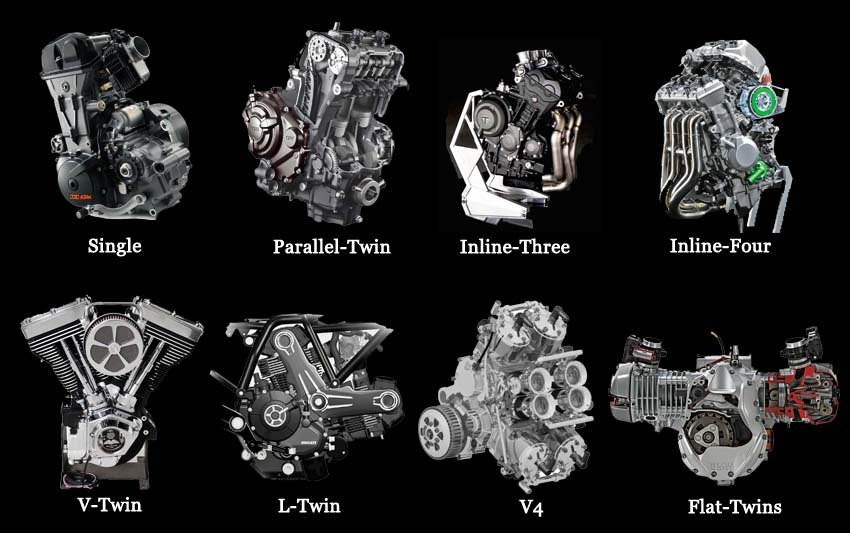
Common types of motorcycle engines
Two-stroke engines pull a charge of air-fuel mixture differently than four-stroke (because they rely on crankcase pressure to move fuel). Many small two-stroke engines use simpler slide-carb designs without gravity feed (since the bike might flip in orientation). Four-stroke street engines commonly use CV carbs or slide carbs. Check what type your engine was designed for.
Intended Use and Riding Style
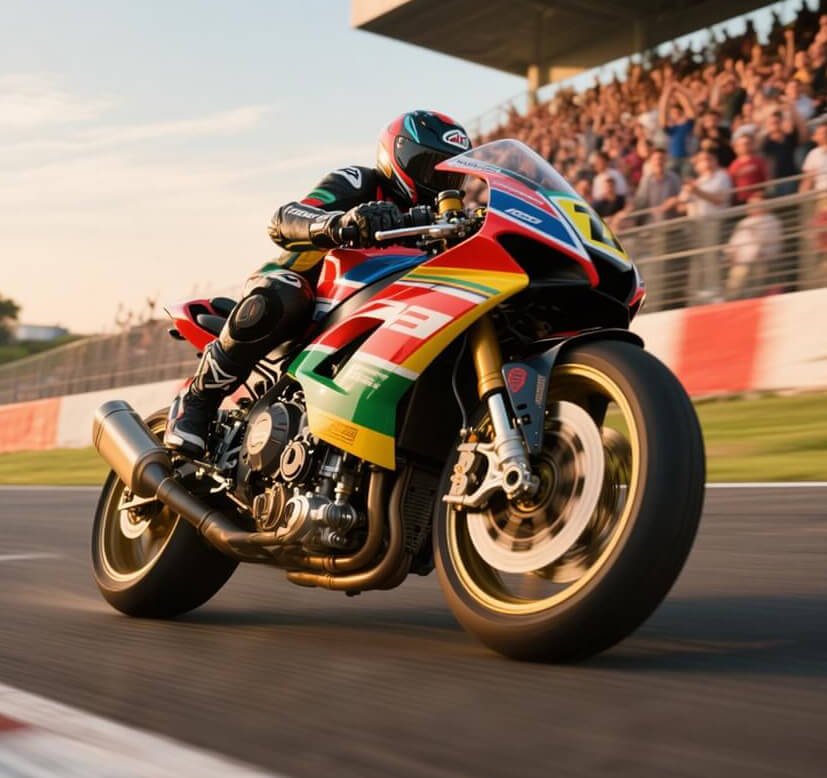
Think about how you ride
Think about how you ride. A performance or racing bike (or spirited off-road dirt bike) often benefits from a mechanical slide carb for instant throttle response. A cruiser, tourer, or commuter might prefer a CV carb for smoothness and idle stability.
If you race or do track days, a high-flow slide carb (with easily adjustable jets) may give more power. For casual street riding, a CV carb’s altitude compensation and less finicky nature might be better.
Altitude and Climate
If you ride at high elevations or in very hot weather, the thin air can make a carb run rich unless tuned. Carburetors are sensitive to air density changes; a bike tuned at sea level will likely run rich on a mountain pass, requiring smaller jets.
Fuel injection automatically adjusts for altitude, but carbs must be rejet by hand. If you live or ride at altitude, plan to rejet or use an altitude kit, or favor a CV carb which mitigates this issue somewhat.
Fuel Delivery (Gravity vs. Pump)
Ensure fuel feed matches the carb. Most motorcycle carbs use gravity-fed fuel (tank above the carb). If your bike has a fuel pump in the tank, some aftermarket carbs may not accommodate pressurized feed. Check the carburetor’s requirement for fuel supply.
Physical Fit and Throttle/Choke Compatibility
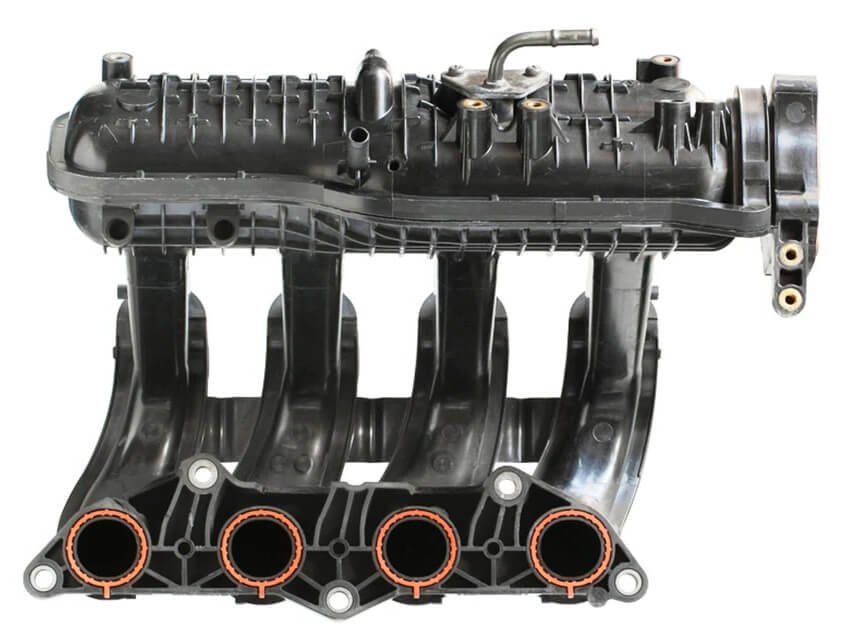
intake manifold
The carburetor must physically fit your bike’s intake manifold. Measure the intake manifold’s inner diameter and make sure the carb’s flange matches (adapters exist but are a hassle). Also, check your throttle cable type (some carbs are pull-type only, others push/pull) and choke style (manual lever vs. vacuum). For example, a carb designed for a manual choke won’t have an electric choke heater. Make sure the carb’s throttle/choke layout suits your bike.
Tuning Support and Parts Availability
A carburetor that is easy to adjust and has available parts is best for beginners. Look for well-known models or brands that have plenty of jets, needles, and spare parts. Carbs with built-in adjustment screws (air/fuel screws, pilot jet screws) let you fine-tune without complex disassembly. Also consider service information: good manuals or online guides will make jetting and syncing much easier. In short, choose a carb with readily available tuning parts and clear support.
Considering these factors – engine specs, how you ride, and practical fitment – will help you narrow down your options when shopping for a motorcycle carburetor.
Tips on Sizing a Motorcycle Carburetor Correctly
Carburetor sizing is partly scientific. The venturi diameter controls airflow velocity: too small a venturi chokes power at high RPM, too large slows airflow at low RPM.
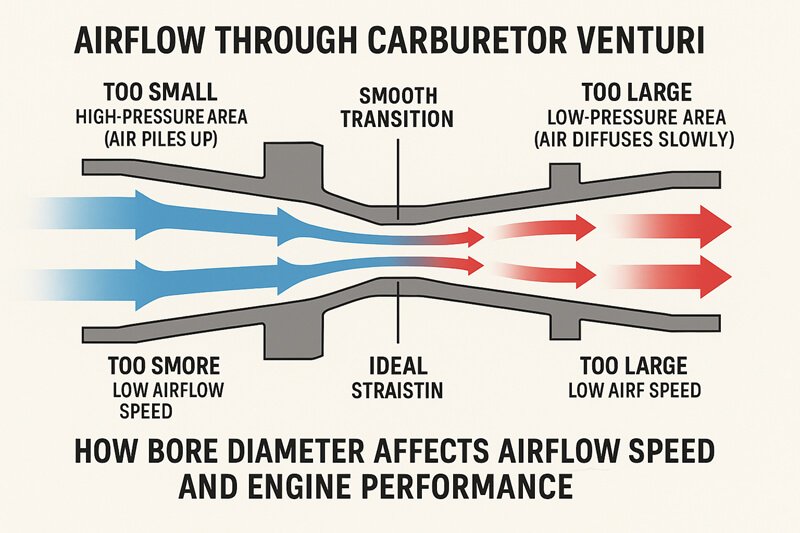
venturi tube airflow principle
A practical tip is to use a carb diameter roughly proportional to engine displacement. In other words, match carb size to engine size: a 125–150cc bike might use a 21–24mm carb, a 250–400cc engine often uses 28–32mm, and a 600cc or larger engine might need 34mm and up. Always check manufacturer or performance tuning recommendations for your engine.
For a more exact method, you can calculate theoretical CFM (cubic feet per minute) using the formula:
CFM = (Engine cc × Max RPM × Volumetric Efficiency) ÷ 3456.
Then choose a venturi size that can pass that CFM at a reasonable airspeed (typically 60–80 m/s in the venturi). This math is advanced, but many riders simply consult tables or ask experts for the right carburetor diameter for a given cc and RPM. The key is not to oversize unnecessarily. In doubt, start with a carburetor size close to stock or just slightly larger.
Remember: you can always jet down (lean out) a little on a slightly larger carb, but a carb that’s too small cannot breathe enough even if jetted rich.
Above all, use the carburetor in the correct range. If your bike’s intake manifold limits the carb size, ensure it still meets your power needs. Consulting guides or using an online carb sizing calculator can help confirm your choice.
Signs You May Need to Upgrade or Replace Your Carburetor
Even a well-chosen carb can wear out or become outmatched. Here are clues that it’s time for service or replacement:
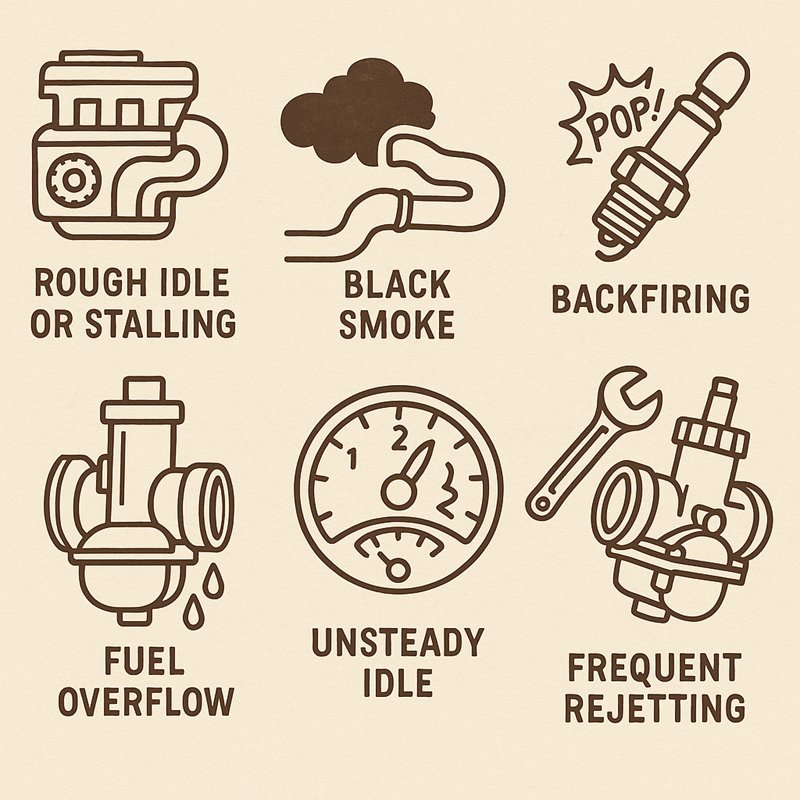
Signs you may need to upgrade or replace your carburetor
- Poor Performance Symptoms: If you notice rough idle, hesitation, low power or poor fuel economy that cleaning and simple tuning don’t fix, the carb may be to blame. For example, rough acceleration, frequent stalling, or black smoke from the exhaust often indicate the mixture is off (too lean or rich).
- Strange Noises and Backfiring: Unusual popping, sneezing, or banging sounds from the engine or exhaust can mean the air-fuel mix is very lean or very rich. A lean mixture can cause the engine to “sneeze” or backfire, while a rich mixture can produce black smoke. If such symptoms appear, inspect the carb for clogged jets, damaged diaphragms, or float issues.
- Hard Starting or Flooding: Difficulty starting, especially when hot or cold, can signal carb trouble. If the carb is flooding (filling with excess fuel), you may see fuel leaking from the bottom or smell raw gas. Flooding often means a stuck float valve or worn needle. Conversely, if the engine won’t start and only runs momentarily on starting fluid, fuel is not reaching the engine (e.g. blocked pilot jet).
- Idle Problems: A carb that refuses to hold a steady idle (either high-idle or stalling at idle) suggests the pilot jet or idle mixture is wrong. High idle that won’t settle may be due to an air leak or throttle slide not seating. An imbalance in the idle circuit can usually be fixed by cleaning or adjusting; persistent issues may warrant a rebuild or new carb.
- Frequent Rejetting Needs: If you continually adjust jets without success (especially after engine upgrades), it may be better to go to a larger carb. For example, increasing bore size or adding high-flow exhaust can exceed what the stock carb can supply. In such cases, swapping to a bigger performance carb can unlock the engine’s potential.
In summary, if routine cleaning and tuning don’t resolve rough running, or if your bike’s modifications and usage demand more airflow than the current carb can give, it’s time to rebuild or replace the carburetor. These upgrades ensure your engine gets the right mix for best performance.
Maintenance and Tuning Basics
Keeping your carburetor clean and properly tuned is key to good performance. Even the best carb will run poorly if dirty or improperly adjusted. Here are beginner-friendly maintenance tips:
Regular Cleaning
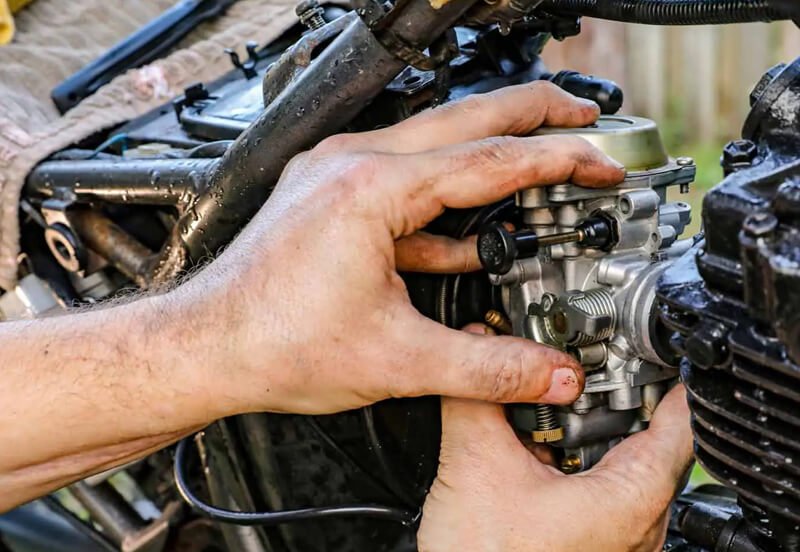
Regular cleaning is important
Carbs accumulate varnish and debris from fuel over time, especially with ethanol-blended fuels. Periodically (e.g. every 5,000–10,000 miles or yearly) remove the carburetor(s), open the float bowl(s), and clean all jets and passages with carb cleaner and compressed air.
Check the float and needle valve for wear or sticking. Clear any blockages in the pilot (idle) jet or main jet. Inspect rubber diaphragms (in CV carbs) for tears. Keeping the carb clean prevents many common running issues.
Inspect and Replace Gaskets/Diaphragms
The gaskets and diaphragms that seal fuel and slides can harden or crack with age. Whenever you rebuild a carb, replace these seals with new ones (OEM or good aftermarket gaskets). A leaking float bowl gasket or torn diaphragm will cause fuel leaks or erratic mixture.
Float Height
Verify the float height per the service manual. If the float sits too high, the carb floods (rich); too low, it starves the engine (lean). Proper float level ensures the fuel bowl stays filled at the correct level. This is often adjusted by bending a little tab on the float needle.
Idle Mixture and Screw Adjustment
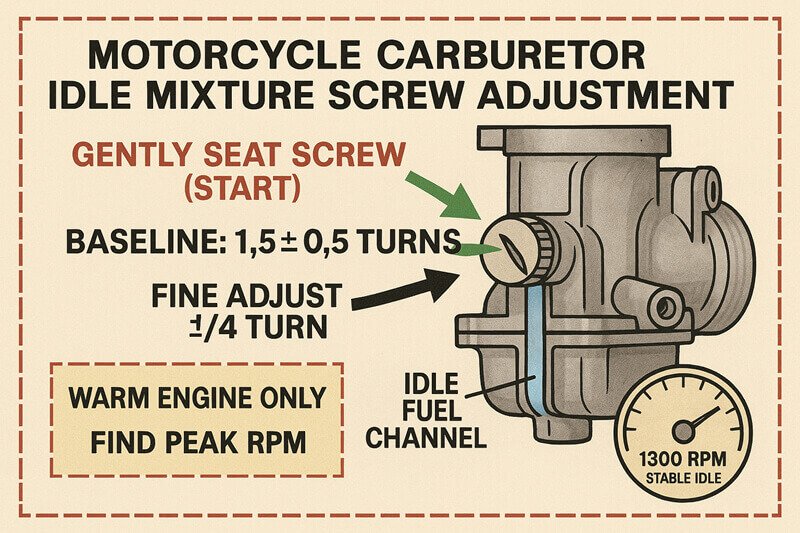
idle mixture and screw adjustment
With the engine warm, set the idle mixture screw so the engine runs smoothly at idle. This usually means turning the screw in or out until you find the highest stable idle (a fine adjustment, typically 1/4 turn at a time). Many carbs have a small “pilot screw” at the base for this. A good starting point is to screw it all the way in (gently) and then back it out 1–2 turns as a baseline.
Idle Speed
Set the throttle stop screw (usually a larger screw) so the engine idles at the correct RPM (refer to your manual). This is done after the mixture is roughly set. The idle speed should not be so high that the bike moves on its own, nor so low that it stalls easily.
Synchronization (for multi-carb bikes)
If your bike has more than one carburetor, they must be balanced (synced) so each cylinder draws the same vacuum. Typically, you idle the bike and adjust small screws so that all gauges read equally. Carolina Cycle recommends syncing every 6,000–12,000 miles. Signs of bad sync include a bumpy idle, uneven throttle response, or surging.
Jetting for Mods and Altitude
Any major changes (airbox, exhaust, altitude) may require new jets. For example, a high-flow air filter or exhaust usually leans out the mix, so a larger main jet is needed. Similarly, riding at high elevation often calls for smaller jets to compensate for the thin air. The main jet affects high-rpm mixture, the pilot (idle) jet affects low-rpm, and the needle (on slide carbs) affects midrange. Keep track of your stock jets so you can compare after changes.
Conclusion
A properly chosen carburetor – one that matches your engine and riding style – is vital for good motorcycle performance. With these tips and by choosing a carb from a reliable brand, even a beginner can safely optimize their bike’s air-fuel system. Happy riding and tuning!

With over 10 years of experience working on cars and trucks Item Training Supervisor Richard Reina is known around the office as one of our technical experts & real an "automobile person".
His rate of interest began, in his very own words, "at the age of two when his father educated him the distinction in between a Chevy and a Ford. Since then it's been cars regularly."
As a serious lover of practically all things with a motor Richard can address nearly any kind of inquiry related to car upkeep, fixing, or restoration & is a fact professional in electric motor background.
Motorcycle riding is all about the sense of freedom, adventure, and thrill of the open road. But come on—being connected when you ride isn't always an easy thing. Whether you're riding with a buddy, navigating traffic in the city, or long-distance riding, effective communication is crucial. That's where the Fodsports T5 and T6 come in, […]
If you're looking for a new motorcycle intercom system this year, Fodsports has something exciting in store. The company has launched two new Bluetooth helmet intercoms: T1 and T1 Pro. Both models bring upgraded features, sleek design, and high-definition audio quality for riders who want to stay connected, entertained, and safe on the road. But […]
Fodsports T1 and T1 Pro: The Newest Bluetooth Intercoms for Riders. Whether you’re cruising on highways, exploring rugged trails, or commuting daily, clear communication is key. Fodsports is thrilled to launch its latest Bluetooth intercoms: the T1 and T1 Pro. Built for riders who demand reliability, versatility, and crystal-clear sound, these devices redefine how you […]
Many riders who aren't so tall or ladies just starting to ride bikes need to pick out the best Motorcycles for Short Riders and Women. They gotta look for three key things: a seat that's not too high up, a bike that's not too heavy, and something that looks good enough to give them confidence. […]
Fodsports FX 60C vs FX30C Pro: What's new techs are the FX 60C bringing to us? Fodsports is a brand worth-mention for helmet communication and video recording. This brand has established itself as a key player with its innovative Bluetooth camera intercom systems. Recently, Fodsports has released a new camera intercom, the FX 60C. How […]
